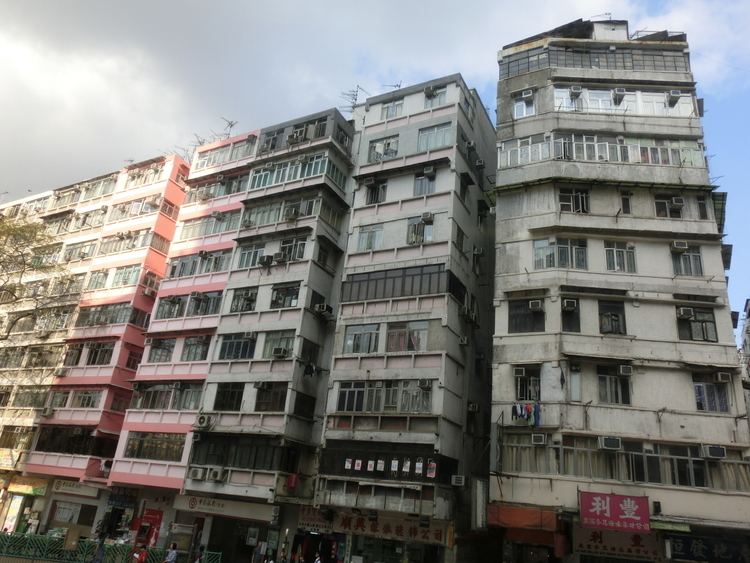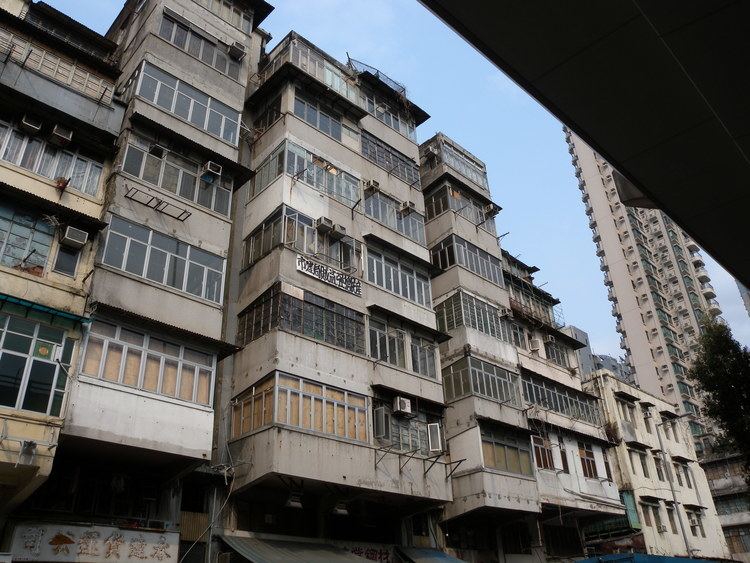 | ||
Similar | ||
The term tong lau or qi lou (Chinese: 唐樓 / 騎樓) is used to describe tenement buildings built in late 19th century to the 1960s in Hong Kong, Macau, southern China and Taiwan. Designed for both residential and commercial uses, they are similar in style and function to the shophouses of Southeast Asia.
Contents
- Overview
- Early tong lau
- Post War tong lau
- Mainland China
- Hainan
- Haikou
- Chengmai
- Wenchang
- Puqian
- Macau
- Hong Kong
- References

Overview

Tong lau is essentially a balcony-type tenement building for residential and commercial use. The ground floor portion is reserved for commercial use, mostly by small businesses like pawnshops and food vendors. The upper floors were residential use and catered to Chinese residents of Hong Kong. Most tong lau were 2–4 storeys tall and 15 feet (4.5 m) in width.
Early tong lau

19th century tong lau encompassed Chinese and European architectural features. The Chinese component was based on building design from southern China, mainly in Guangdong Province. European influences were usually Neoclassical.
The tong lau roof used wood and/or Xieding tiles and iron was used for the balconies. The balcony's design was based on Cantonese styles. Windows used French styling and were made of wood and glass.
The upper floors were supported by brick pillars and protruded out to the edge of the street.
Inside, the floors were connected by wooden stairs. Most floors ranged from 450–700 square feet with very high ceilings. Top floors were often living quarters for shopkeepers and their family.
Other architectural features of early tong laus:
An example of early tong lau or Kee-lau is Lui Seng Chun, a reinforced concrete building built in Hong Kong in 1931.
Post War tong lau
Tong lau built after World War II were simpler in design:
Iron balconies were replaced with concrete ones and later sealed with windows. Roofs were often flat with an open terrace and later renovated to allow for additional residential space.
Wooden windows gave way to stainless steel windows. Air conditioning units were added to the windows in the 1970s and 1980s. Often clothes racks were added below the windows and hung above the sidewalk or street below. Signs were hung on the exterior walls and protruded onto the streets below.
Other features of the new tong lau included:
The post-war boom and influx of immigrants meant Hong Kong ran short of housing. Tong lau were seen as a solution and many of these buildings were renovated to become rental units.
Rooms on the upper floors were divided into smaller rooms and sublet as units by owners. They would only accommodate bunk beds. The middle of the floor was common space for tenants to eat and stretch. Bathrooms and kitchens were also shared amongst the tenants on each floor. Tenants paid for electricity and water on a monthly basis.
The sublet of floors in the tong lau results in changes in housing regulations in Hong Kong (Laws of Hong Kong 123 °F (51 °C) chapter "Building (Planning) Regulations", 46).
After the 1960s, many tong lau were demolished to give way to taller apartment and commercial buildings. Comparatively few tong lau are found in Hong Kong today.
On 29 January 2010, there is a significant incident of spontaneous whole-building-collapse at no.45J, Ma Tau Wai Road, Ma Tau Wai, when a five-storey tong lau of more than 50 years history suddenly collapsed at approximately 1:43 pm. There are four people killed, buried under the debris. Such spontaneous, cascading and complete building-collapse in Hong Kong is quite rare since the Second World War and the incident raised concern of the HKSAR Government and the Hong Kong Public towards the safety of the aging "Tong lau" population in Hong Kong especially those built with similar specifications about 50 or more years ago.
Mainland China
Southern China, namely cities in Guangdong Province, is where the tong lau or Qilou (Chinese: 騎樓) originated in the late 19th century. They were built by wealthy Chinese merchants in the cities like Guangzhou.
Qilou styles varied from Chinese to European:
Locations in Guangzhou with Qilou:
Hainan
Tong lau buildings exist in numerous towns and cities in the southern island province of Hainan. Usually concentrated in a single area, these buildings are often dilapidated. In some cities, such as Haikou and Wenchang, the buildings have been restored.
Haikou
The historical Bo'ai Road area is located in the heart of the capital city of Haikou. Nearly all the buildings in this neighbourhood are tong lau style. Beginning around 2012, the entire area has been undergoing restoration. It started with Zhongshan Road, now completed and converted into a pedestrian zone. The restoration is currently expanding outward with the facades being replastered and painted. Lights facing toward the facades to illuminate them at night are now installed on many of the buildings. With road repair ongoing, and new, tourist-related businesses replacing the old shops, the entire area is being developed as a visitor attraction.
Chengmai
The southern part of the town of Chengmai, located in Chengmai County, has a neighbourhood running along the Nandu River that consists of numerous, dilapidated tong lau buildings.
Wenchang
The tong lau buildings in the city of Wenchang's "Wennan Old Street" have been completely restored. Unlike Haikou's Bo'ai Road area, the facades are unpainted and appear gray in colour. The area is located downtown and is a visitor attraction.
Puqian
An area within the town of Puqian, mostly consisting of a single street, is lined with tong lau buildings. The street is the main route from the port to the town centre. The tong lau buildings are in serious disrepair, many of which are structurally unsafe.
Macau
Tong lau are also found in Macau on Avenida de Almeida Ribeiro near the Largo do Senado. They are better preserved in Macau, where they did not give way to newer buildings. Upper floors no longer house people and often reused for commercial use. tong lau here often feature Portuguese colonial architectural influences.
Hong Kong
The existence of tong laus was a culmination of a series of historic forces from economic development of Hong Kong, Second World War as well as the influx of Chinese migrants to Hong Kong.
In 1898, the government introduced a building and public health ordinance which defined all the buildings including tong laus. In 1903, the government introduced a maximum height per storey of 9 feet (2.7 m), with a four storey limit. This explains the general appearance of Tong laus. Yet, the ordinance changed in 1964, so no tong lau was built from then on.
Tong laus are mainly distributed in the following areas in Hong Kong:
